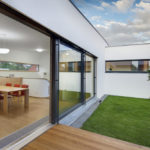Home automation covers a broad range of appliances, amenities, and other conveniences. Given the large scale of household chores and activities that can be carried out automatically, automating your home can superficially appear both daunting and expensive. However, once you understand the broad strokes of creating a smart home, from setting up a central hub to figuring out which tasks you’d like to connect to the system, it’s both reasonably affordable and easy to set up and maintain a home automation system from a company like AMP Smart.
The Basics
The first step in setting up automation in your home is determining which tasks you’d like your system to manage. Creating a smart home leaves plenty of room for customization and no two smart homes will be exactly alike. Generally speaking, you can look at automation as dividing into two distinct categories: devices and amenities. The device category includes audio and visual entertainment systems, computers, and appliances like washers and dryers. Amenities includes lighting, sprinklers, heating and air conditioning, security systems with cameras and door alarms, and other larger-scale systems in and around your home.
While these devices can be automated on a one-to-one basis, the best approach is to create a central control hub for the ultimate smart home experience. This central hub can be a physical unit or control panel, but it can also be achieved through apps that work with your existing tablet or smartphone, though this may depend on the scale of the system, and some mixing and matching is possible. A tablet offers more on-the-go control, but a dedicated console is inherently more secure because it is stationary.
Home automation uses a broad range of protocols, including Wi-Fi, Bluetooth, and more specialized platforms like Z-Wave, Thread, Zigbee, and X-10. While the choice is ultimately up to you, a mixed approach built around wi-fi and Z-wave is commonly suggested, as you’re likely experienced with wi-fi and Z-wave has widespread support on a range of devices and systems.
Where to Start
If this is your first time automating aspects of your household, you’ll likely want to do a mix of devices and amenities. Stick with the amenities you already have before adding additional systems like security or smart lawn irrigation. Your HVAC amenities, which includes your heating, ventilation, and air conditioning are a perfect starting point. Smart thermostats are surprisingly affordable and simple to install. As a bonus, homeowners with a smart thermostat save around 10 percent annually on energy bills, meaning you’ll quickly recoup the cost of the unit.
Smart light switches and outlets are another house-wide amenity that can easily be adapted. Light timers have been popular for decades as both a convenience and handy security feature and can now be integrated into a larger smart home system. By integrating these with smart switches and outlets, you can not only automate your indoor and outdoor lighting, but also remotely control power to a whole range of devices, be it computers and printers, kitchen appliances, or your washer and dryer units.
Automating your devices can be more involved than just remotely controlling their power supply. There’s a broad range of wireless devices that can be linked up to a central hub for ease of control. One of the more interesting features these offer is the use of smart sensors. By detecting your comings and goings, smart sensors can automatically turn lights and devices on and off depending on whether or not you’re home or in a specific room. They aren’t essential, but are definitely a huge convenience and set your system apart from other smart homes. As said, there are a broad range of devices with smart and automated capabilities, including integrated home audio systems, surveillance cameras, and even coffee pots.
The Sky’s the Limit
The level of automation achievable in your home is really only limited by your imagination. Now that a few generations of products have been released, the cost has settled to a point where it’s possible to have smart home features on any budget. Familiarize yourself with the various protocols used for smart technology and try to aim for consistency, as this will ease the process of placing all your devices and amenities under a central control hub. Focus on automating things you use every day, like lighting or heating, and from there branch out into more exotic implementations.
Guest Post By:
Dixie Somers / Freelance Writer
dixiesomers@gmail.com







